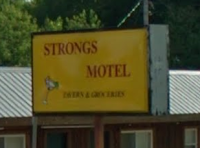In 1868,
Rutland was devastated by a series of major fires, one almost every week. Many of Rutland's prominent buildings were destroyed,
some by accident and others by arson. During
that year, “incendiaries” kept everyone wondering where they would strike
next.

In December, Rutland's first
Town Hall burned, west of the corner of Main and Washington Streets, as well as
a few barns. J.S. Hunt & Co., an
insurance company in Boston, hired George W. Whipple, a detective from New
York, to investigate the “incendiaries”.
As he later testified in criminal court, he spent some time “canvassing the town; I mean by that, that I looked up the habits and customs
of the lowest class of the people.” He
befriended Pete Neary, and found out that he had access to the jail and wanted
to free his friend, the infamous forger O.B. Clark, alias Edward L. Piper. (Remember him from the earlier post? “Rutland Jailhouse Fire 1867”) But Neary was reluctant to help Clark escape
while Mr. Briggs served as jailer, since he was also friends with the jailer.
Pete Neary went about town, or at least among “the lowest
class of the people”, trying to recruit assistant arsonists. He told friends that he had been offered
$3,000 for a job “to burn some buildings”, and was offering each of his helpers
$500. The men supposed that Neary wanted
to get O.B. Clark out of jail, and that Clark would pay them for enabling him
to escape. These men were urged by wives
and girlfriends to do the job and get the good payoff.
Watchmen had been set to guard the town, so Neary planned to
burn some barns nearby and across Main Street to distract them. He was smart enough to avoid the barn of
Leeds Billings, because he kept large dogs.
A couple of men climbed into the hayloft of each barn to set hay on
fire, and left the doors barred against firefighters. Then they went to set the important buildings
on fire, extract the prisoner, and earn their reward. They failed, however, to get O.B. Clark out of jail.
After these fires, 6 conspirators were arraigned: Pete
Neary, Bill & Jim Butterfly, Tom & Mary Dushan, & Martin
Duffy. Another detective, George W. Chapman,
arrived from Boston to help Whipple with the investigation. The forger O.B. Clark was moved elsewhere.
Perhaps these harum-scarum accomplices are the reason that a mere forger was considered to be such a dangerous criminal.
 |
| Rutland Jailhouse |
By this time, Duffy was ready to help the police convict
Pete Neary and two accomplices, Bill Butterfly & Tom Dushan. Neary, Butterfly, & Dushan were put in
the lower dungeon of the jailhouse, and Martin Duffy, and the two detectives,
Whipple & Chapman, were above them in the marble-walled cell that O.B.
Clark had formerly occupied.
By calling
through the hole in the floor next to the stovepipe, a conversation could be
held between these cells. As described
in court testimony, Duffy rapped on the stove pipe, and said, “Is that you
Bill?” The reply was “yes”. Butterfly asked, “Is that you Duffy?”, and he
said “yes”. Butterfly was suspicious
about this being a set-up by police or detectives. He asked Duffy, “Are you alone?” and Duffy
said “yes”. Butterfly then asked,
"Have you said anything to expose us about the fires?" Duffy said "no," so Butterfly said,
"All right, keep mum, and we shall be all right."
Pete Neary and Bill Butterfly were convicted of arson, and
sentenced to 10 years in state prison.
Martin Duffy was found guilty but not convicted. The final disposition of Martin Duffy's case
was guilty but "nolle prosequi", which means literally "do not
prosecute". It describes a
prosecutor's decision to discontinue criminal charges before a verdict is
rendered.
The new Killington Steamer that had been purchased that
October was said to have paid for itself in fighting the Town Hall fire in
December. The destruction could have
been much worse.


















































